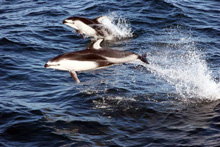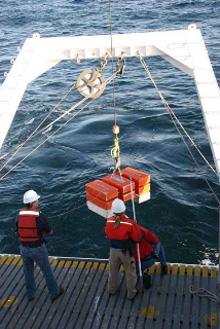
Pacific white-sided dolphin (Lagenorhynchus obliquidens) leap above the ocean waves. Click image for larger view and image credit.
Cruise participants deploy the acoustic Doppler current profiler (a type of current meter) from the aft deck of the research vessel Western Flyer. Click image for larger view and image credit.
Welcome Aboard
January 26, 2006
Andrew DeVogelaere, PhD
Marine Scientist
Monterey Bay National Marine Sanctuary
NOAA
On the first day of any research cruise, scientists are “welcomed aboard” with an orientation to the ship, safety protocols, and a practice session of putting on survival suits. On this particular cruise, were also welcomed out to sea by a raft of about 30 sea otters while leaving Moss Landing Harbor, and pods of Pacific white-sided dolphins, northern right-whale dolphins, and Dall’s porpoises. The team was excited to get out to sea after all the months of planning, and excited by the numerous photo opportunities that the Monterey Bay National Marine Sanctuary environment had to offer.
Today, we also want to welcome you "aboard" the Ocean Explorer Web log, and we invite you to follow the expedition team's daily progress as we explore the fascinating Davidson Seamount, located off the coast of central California.
During the six-hr cruise from the research vessel Western Flyer’s home port to the Davidson Seamount, the collaborative scientists got more familiar with each other, the remotely operated vehicle (ROV) pilots, and the ship’s crew. It’s an outstanding group.
Today, we placed two current meters at Davidson Seamount. We will be now be able to measure water-flow hundreds of meters above the seamount, in a valley floor, adjacent to the highest peak on the seamount. Tomorrow we will place a current meter on the peak. In the essay on technology, you will find that we will also be measuring fine scale currents immediately next to corals with instruments held by the ROV's mechanical arm. With information at these different scales, we will better understand how water flow influences where corals live and how big they get.
On our first ROV dive we saw jumbo flying squid, vase sponges, and bamboo corals. For all of you interested students: Yes, we have already started doing the pressure experiments on the styrofoam cups . . .
.
Sign up for the Ocean Explorer E-mail Update List.





















